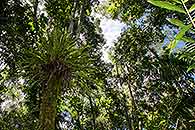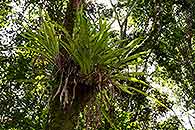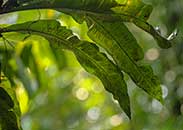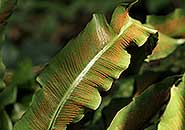Asplenium africanum Desv.
Synonyms |
Asplenium sinuatum P.Beauv. |
|---|---|
Common name |
|
Description |
Rhizome erect or shortly creeping, fleshy; rhizome scales lanceolate in outline, apex tapering to a point and ending in a hair-tip, base swollen, margin entire to wavy or crenate, with thick, up to 11 x 1.5 mm, dark brown cell walls and translucent lumen. Fronds monomorphic, tufted, drooping, slightly fleshy, not proliferous. Stipe thick, grooved, gradually attenuate from lamina but sometimes seemingly to 25 cm long, with a few scales at the very base. Lamina simple, lanceolate or strap-shaped, 25–100 x (2.2–)3–8 cm, margin entire, base and apex tapering, glabrous; costa clear, flattened; veins many, free, forking, 6–7 per cm, at angle of 45–70° with costa, marginal vein absent. Sori many along the veins, linear, long ones alternating with occasional short ones, 9–30 mm long, reaching neither costa nor margin; indusium membranous, entire, pale, to 0.7 mm wide. |
Notes | A. africanum is distinguished from other taxa in Asplenium by a simple lamina that has no marginal vein and is longer than 25 cm, rhizome scales with an entire margin. |
Derivation | africanum: from Africa. |
Habitat | Moist forest, often near water. |
Distribution worldwide | See African distribution. |
Distribution in Africa |
Angola, Benin, Cameroon, Central African Republic, Congo, Dem. Republic of Congo, Equatorial Guinea (incl. Bioko), Gabon, Ghana, Guinea, Ivory Coast, Kenya, Liberia, Niger, Nigeria, Rwanda, Sierra Leone, Tanzania , Uganda. |
Growth form |
Epiphytic, lithophytic. |
Literature |
|




